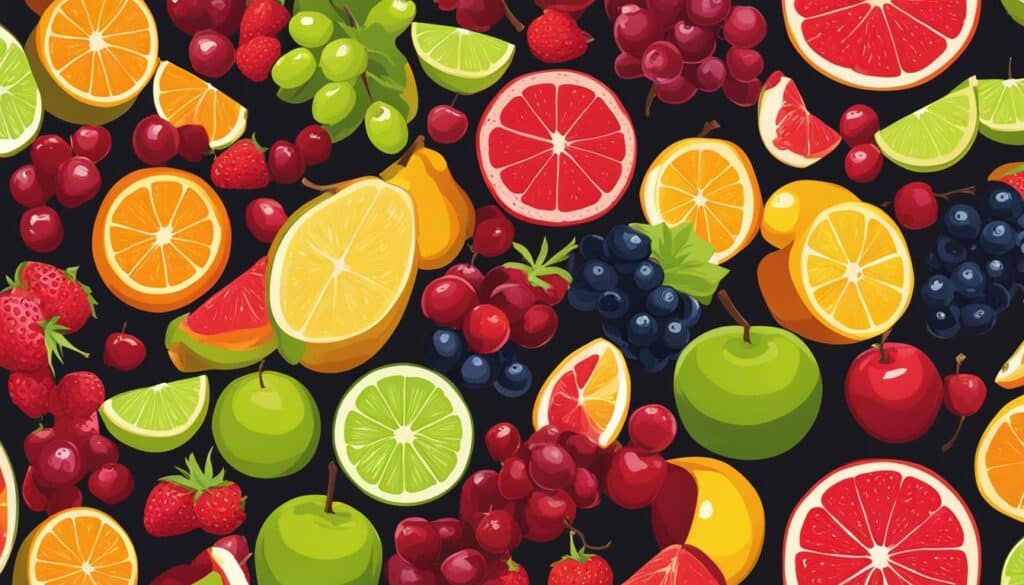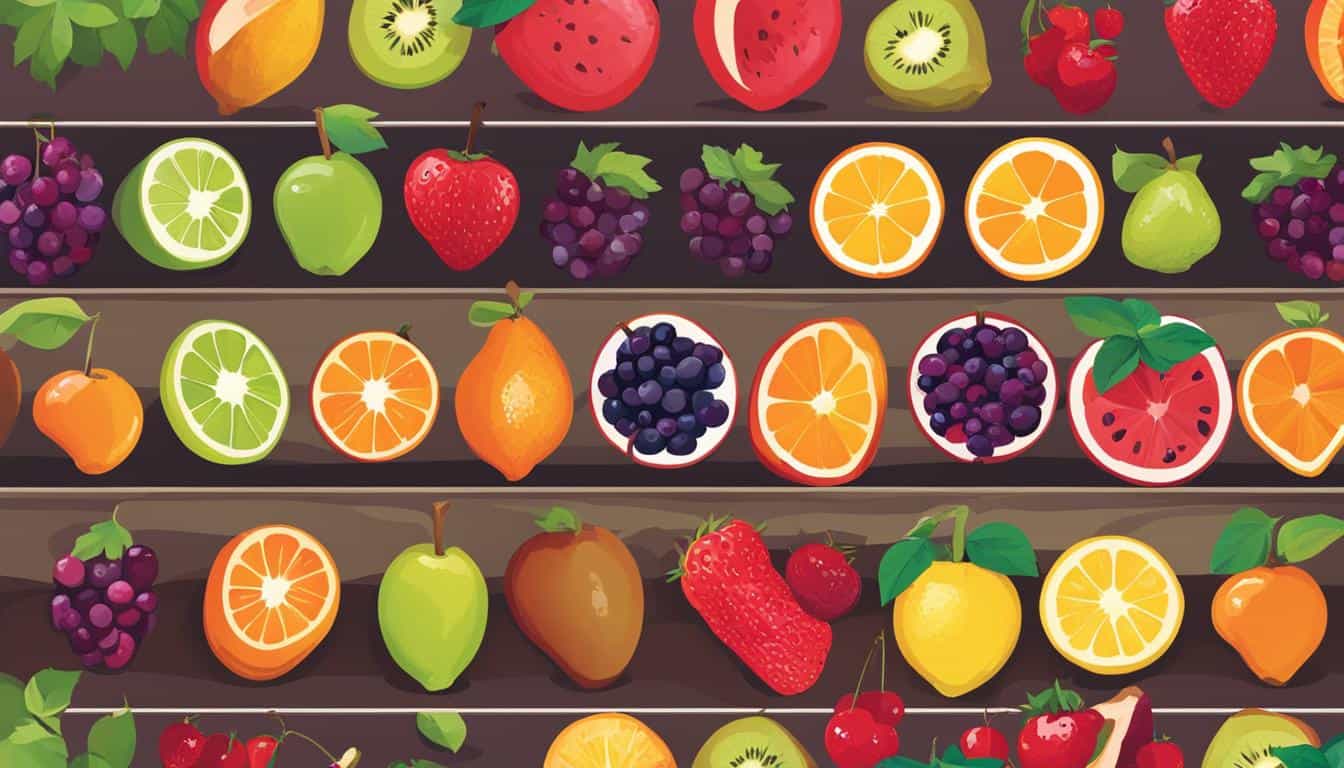I’m excited to share with you a comprehensive guide on fruits that are safe for dogs to eat. As pet owners, we want to ensure our furry friends are getting the best nutrition possible while keeping them safe and healthy. In this article, I will provide you with a chart of fruits that dogs can enjoy in moderation, along with important information about each fruit.
Key Takeaways:
- It’s important to choose fruits that are safe for dogs and feed them in moderation.
- Dogs can benefit from the nutritional value of fruits, but they are not essential in their diet.
- Some fruits can be toxic to dogs and should be avoided.
- When feeding fruits to dogs, take proper precautions and ensure they are prepared safely.
- Incorporating fruits into a dog’s diet can provide additional nutrients and benefits.
Always consult with a veterinarian before introducing any new fruits into your dog’s diet, as some fruits may be harmful to dogs.
Understanding the Importance of Dog-Safe Fruits
Dogs are omnivores and can benefit from the nutritional value of fruits. While fruits are not essential for a dog’s diet, they can provide vitamins, minerals, and antioxidants. Fruits are often included in commercial dog foods because they offer additional nutrients. However, it’s crucial to choose fruits that are safe for dogs and feed them in moderation.
Feeding dogs a variety of fruits can contribute to their overall health and well-being. Fruits such as apples, bananas, and blueberries can provide vitamins A, C, and K. These vitamins support immune function, promote healthy skin and coat, and aid in proper blood clotting.
In addition to vitamins, fruits also contain dietary fiber, which can aid in digestion and promote good gut health. Fiber helps regulate bowel movements and prevents constipation. It can also help dogs maintain a healthy weight by promoting a feeling of fullness and preventing overeating.
When introducing fruits into a dog’s diet, it’s important to start with small amounts and monitor their reaction. Some dogs may have sensitivities or allergies to certain fruits. If any adverse reactions occur, such as vomiting, diarrhea, or skin irritations, it’s best to discontinue feeding that particular fruit and consult with a veterinarian.
Understanding the Benefits of Dog-Safe Fruits
Adding dog-safe fruits to a canine’s diet can provide several benefits. These include:
- Increased intake of essential vitamins and minerals
- Promotion of healthy digestion and bowel movements
- Boosting the immune system
- Improving skin and coat health
- Supporting proper blood clotting
By incorporating a variety of fruits into a dog’s diet, pet owners can enhance their overall nutrition and contribute to their well-being. However, it’s important to remember that fruits should only be given in moderation and as part of a balanced diet that includes other essential nutrients from animal-based proteins.
Fruits Dogs Can Eat: A Comprehensive List
When it comes to feeding our furry friends, it’s important to know which fruits are safe for them to enjoy. Below is a comprehensive list of fruits that are suitable for a dog’s diet, along with some key information about each fruit:
Guide to Fruits Dogs Can Eat
| Fruit | Health Benefits | Serving Size |
|---|---|---|
| Apples | Rich in vitamins A and C, fiber | Remove seeds and core, feed in small slices |
| Strawberries | High in antioxidants, vitamin C | Remove the green tops, serve in small pieces |
| Blueberries | Great source of antioxidants, fiber | Serve in moderation as a treat |
| Watermelon | Hydrating, low in calories | Remove seeds and rind, serve in small chunks |
| Bananas | Good source of potassium, vitamin B6 | Peel and feed in small pieces |
| Pineapple | Contains bromelain, aids digestion | Remove skin and core, serve in small portions |
Remember, even though these fruits are safe for dogs to eat, moderation is key. Too much of any fruit can upset a dog’s stomach, so it’s best to introduce new fruits gradually and in small amounts. If you have any concerns about your dog’s specific dietary needs or health conditions, consult with your veterinarian before adding new fruits to their diet.
Now that you have a guide to the fruits that are suitable for dogs, you can confidently offer them a variety of healthy and delicious treats. Just remember to always prioritize your dog’s well-being and monitor their intake to ensure they stay happy and healthy.
Fruits Dogs Should Avoid

While many fruits are safe and beneficial for dogs to consume, there are certain fruits that can be toxic and dangerous to their health. It’s important for dog owners to be aware of these fruits and avoid feeding them to their furry companions. Some common fruits that dogs should avoid include:
- Grapes and raisins: These fruits contain substances that can cause kidney failure in dogs, leading to serious health complications.
- Avocado: Avocado contains a toxin called persin, which can be toxic to dogs and may cause vomiting, diarrhea, and other digestive issues.
- Citrus fruits: Citrus fruits like oranges, lemons, and limes contain citric acid, which can cause upset stomach, vomiting, and even central nervous system depression in dogs.
- Cherries: The pits and stems of cherries contain cyanide, which is toxic to dogs. Ingesting these parts of the fruit can lead to respiratory distress and other health problems.
- Stone fruits: Stone fruits such as peaches, plums, and apricots contain pits that can pose a choking hazard to dogs. Additionally, the pits contain cyanide, which is toxic to dogs.
It’s important to note that this is not an exhaustive list, and there may be other fruits that can be harmful to dogs. If you’re unsure about the safety of a particular fruit, it’s best to consult with a veterinarian before offering it to your dog.
“Certain fruits can be toxic and dangerous to dogs, so it’s crucial to be knowledgeable about what fruits to avoid. Always prioritize the health and well-being of your furry friend.”
In addition to avoiding these fruits, it’s also essential to remove any seeds, pits, or stems from the fruits that you do offer to your dog. These parts can pose a choking hazard or contain toxic substances. It’s always better to be safe than sorry when it comes to your dog’s health.
Remember, if your dog accidentally ingests a fruit that is potentially toxic, contact your veterinarian immediately. Prompt veterinary care is crucial to ensure the best possible outcome for your furry friend.
Preparing Fruits for Dogs
When it comes to feeding fruits to your furry friend, it’s important to take the necessary precautions to ensure their safety and enjoyment. Here are some tips for preparing fruits for dogs:
Wash Thoroughly:
Before serving fruits to your dog, make sure to wash them thoroughly to remove any dirt, pesticides, or harmful bacteria that may be present on the skin. This will help prevent any potential digestive issues or illnesses.
Remove Seeds and Pits:
Many fruits contain seeds or pits that can be hazardous for dogs if ingested. These seeds and pits can pose a choking hazard or cause blockages in their digestive system. Always remove seeds and pits before giving fruits to your dog.
Cut into Bite-Sized Pieces:
Depending on the size of your dog, it’s important to cut the fruits into bite-sized pieces that are easy for them to chew and swallow. This will help prevent any choking incidents and make it more enjoyable for your dog to eat.
Introduce New Fruits Slowly:
If you’re introducing a new fruit to your dog’s diet, it’s best to do so gradually. Start by offering a small amount and monitor their reaction. Some dogs may have sensitivities or allergies to certain fruits, so it’s important to observe any signs of discomfort or adverse reactions.
By following these simple guidelines, you can ensure that your dog safely enjoys the benefits of fruits in their diet. Remember to always consult with your veterinarian before making any significant changes or additions to your dog’s diet.
| Fruit | Safe for Dogs | Preparation |
|---|---|---|
| Apple | Yes | Remove the core and seeds, cut into small pieces |
| Blueberries | Yes | Wash thoroughly and serve as is |
| Banana | Yes | Peel and cut into small slices |
Remember, each dog is unique, and their dietary needs may vary. It’s always best to consult with a veterinarian to ensure that the fruits you offer are safe and appropriate for your dog’s specific needs. Enjoy sharing the goodness of fruits with your canine companion!
Benefits of Fruits in a Dog’s Diet

Fruits can provide several benefits when incorporated into a dog’s diet. They are a rich source of vitamins, minerals, and antioxidants, which can contribute to overall health and well-being. Fruits such as apples, bananas, and blueberries are especially beneficial for dogs due to their high nutrient content.
One of the main advantages of including fruits in a dog’s diet is their potential to support the immune system. The antioxidants found in fruits help to fight against free radicals, reducing the risk of oxidative stress and inflammation. This can enhance the dog’s ability to ward off illnesses and diseases.
Fruits also offer a source of dietary fiber, which can promote healthy digestion in dogs. Fiber helps regulate bowel movements and can prevent constipation. It also aids in weight management by promoting feelings of fullness and reducing overeating. Additionally, fruits can contribute to the hydration of dogs, especially those with high water content like watermelon and oranges, helping to maintain proper hydration levels.
It’s important to note that while fruits can provide numerous benefits, they should always be fed in moderation. Due to their natural sugar content, excessive fruit consumption could lead to weight gain or digestive issues in dogs. It’s essential to consult with a veterinarian to determine the appropriate amount of fruits to include in a dog’s diet based on their individual needs and health condition.
| Fruit | Nutritional Value | Benefits |
|---|---|---|
| Apples | Rich in vitamin C and fiber | Supports immune system, aids in digestion |
| Bananas | Good source of potassium and vitamin B6 | Provides energy, promotes heart health |
| Blueberries | Packed with antioxidants and vitamins | Supports brain function, improves heart health |
| Strawberries | High in vitamin C and fiber | Boosts immune system, promotes healthy skin |
Remember, every dog is unique, and it’s important to introduce fruits gradually and monitor their response. Not all dogs may tolerate certain fruits, and some may have allergies or sensitivities. If any adverse reactions occur, such as gastrointestinal upset or allergic symptoms, discontinue feeding the fruit and consult with a veterinarian.
When chosen thoughtfully and fed in the right amounts, fruits can be a valuable addition to a dog’s diet. They offer nutritional benefits, support the immune system, aid digestion, and promote hydration. By incorporating fruits into a balanced canine meal plan, owners can provide their furry companions with a flavorful and nourishing diet.
Incorporating Fruits into Meals and Treats

When it comes to incorporating fruits into your dog’s meals and treats, there are plenty of creative and delicious options to explore. Fruits can be a nutritious and tasty addition to your dog’s diet, providing them with a variety of vitamins, minerals, and antioxidants. Here are some ideas to help you incorporate fruits into your furry friend’s meals and treats:
Mixing with Dog Food
One simple way to introduce fruits to your dog’s diet is by mixing them with their regular dog food. You can finely chop or mash fruits like apples, bananas, or berries and mix them in with their kibble. This adds a burst of flavor and extra nutrients to their meals, making them even more enticing.
Training Rewards
Fruits can also be used as tasty and healthy training rewards for your dog. Cut up small, bite-sized pieces of fruit, such as watermelon, cantaloupe, or blueberries, and use them as rewards during training sessions. Not only will your dog love the delicious treats, but they will also benefit from the natural sweetness and nutritional value of the fruits.
Puzzle Toys and Frozen Treats
If your dog enjoys puzzle toys or frozen treats, you can incorporate fruits into these as well. Fill puzzle toys with small pieces of fruit, like sliced apples or frozen grapes, to provide mental stimulation while they try to extract the treats. You can also freeze mashed fruits, such as bananas or strawberries, in ice cube trays to create refreshing and healthy frozen treats for your dog on hot summer days.
| Fruit | Benefits | Precautions |
|---|---|---|
| Apples | Rich in vitamins A and C, fiber, and antioxidants | Remove the core and seeds, as they can be choking hazards |
| Bananas | Good source of potassium, fiber, and essential vitamins | Feed in moderation due to their high sugar content |
| Blueberries | Packed with antioxidants and beneficial nutrients | Offer in small amounts, as they can cause stomach upset if consumed excessively |
| Watermelon | Hydrating and contains vitamins A, B6, and C | Remove the seeds and rind to avoid choking hazards |
Remember to introduce fruits gradually into your dog’s diet and monitor their reaction. If you notice any signs of digestive upset or allergies, consult with your veterinarian. By incorporating fruits into your dog’s meals and treats, you can provide them with a healthy and varied diet that they will truly enjoy.
Knowing Your Dog’s Limits
When it comes to feeding fruits to your dog, it is essential to understand their individual needs and limitations. While certain fruits may be safe for one dog, they may not be suitable for another. Introducing new fruits into their diet should be done gradually and with careful observation.
Start by offering small amounts of the fruit and monitor your dog’s reaction. Look for any signs of discomfort or digestive issues. It is also important to keep in mind that some dogs may have allergies to specific fruits. If you notice any adverse reactions like itching, vomiting, or diarrhea, discontinue feeding that fruit immediately and consult with your veterinarian.
It is a good practice to introduce one fruit at a time, allowing a few days to pass before introducing another. This will help you identify any fruits that may not agree with your dog’s digestive system. Additionally, different breeds may have different tolerances to certain fruits, so what works for one breed may not work for another.
Monitoring Fruit Consumption
While fruits can provide nutritional benefits, it is important to remember that they should only be fed in moderation. Fruits contain natural sugars, and excessive consumption can lead to weight gain and other health issues in dogs. Always keep track of the quantity of fruits your dog consumes and consider it as part of their overall calorie intake.
To ensure a balanced diet, fruits should not make up the majority of your dog’s meals. They should be provided as occasional treats or as a supplement to their regular diet. If you have any concerns about the quantity of fruits your dog should consume, consult with your veterinarian for specific guidance based on their size, breed, age, and overall health.
| Fruit | Serving Size | Potential Benefits | Potential Risks |
|---|---|---|---|
| Apple | 1-2 slices | High in fiber and vitamin C | Avoid apple seeds as they contain cyanide |
| Watermelon | 1-2 cubes | Hydrating and contains vitamins A and C | Avoid seeds and rind as they can cause blockage |
| Banana | Half a banana | Good source of potassium and fiber | High in sugar, feed in moderation |
| Blueberries | A handful | Rich in antioxidants and vitamins | None, but introduce in small amounts |
Remember, it is always best to consult with your veterinarian before introducing any new foods to your dog’s diet. They can provide you with personalized advice based on your dog’s unique needs and health considerations. By being attentive to your dog’s individual needs and monitoring their fruit consumption, you can ensure that they enjoy the benefits of fruits while staying healthy and happy.
Monitoring Fruits Consumption and Seeking Veterinary Care

As responsible pet owners, it is crucial to monitor the consumption of fruits in our canine companions. While fruits offer many health benefits, overindulgence can lead to gastrointestinal upset or other adverse reactions. It is essential to feed fruits to dogs in moderation, ensuring that they are part of a balanced diet.
When introducing new fruits to your dog’s diet, start with small amounts and observe their reactions. Look for any signs of discomfort, such as vomiting, diarrhea, or changes in behavior. Each dog is unique, and what may be safe for one may not be suitable for another. Pay attention to your dog’s individual needs and adjust accordingly.
If you suspect that your dog has consumed a toxic fruit or is experiencing symptoms of fruit poisoning, it is crucial to seek veterinary care immediately. Time is of the essence when dealing with potential toxin ingestion, as quick intervention can increase the chances of a full recovery. Contact your veterinarian as soon as possible to discuss the situation and follow their guidance.
Remember, prevention is key in keeping our furry friends safe. Familiarize yourself with the list of fruits that are safe for dogs and those to be avoided. By being proactive and vigilant, we can ensure that our dogs enjoy the benefits of fruits while minimizing the risks associated with improper consumption.
Conclusion
In conclusion, incorporating fruits into a dog’s diet can provide numerous benefits. It’s essential to choose fruits that are safe for dogs and feed them in moderation. By referring to the chart of dog-safe fruits provided in this guide, you can ensure the health and well-being of your canine companion.
Remember that every dog is unique, and what may be safe for one may not be suitable for another. Pay attention to individual needs and reactions when introducing new fruits. Start with small amounts and observe any changes in health or behavior.
While fruits offer health benefits, it’s crucial to monitor their consumption. If you suspect your dog has ingested something toxic or shows symptoms of fruit poisoning, contact your veterinarian immediately. Prompt veterinary care is essential for the best chance of a full recovery.
FAQ
Are all fruits safe for dogs to eat?
No, not all fruits are safe for dogs to eat. Some fruits can be harmful to their health.
Why should I feed fruits to my dog?
Fruits can provide vitamins, minerals, and antioxidants that can benefit your dog’s health.
Can I feed fruits to my dog as treats?
Yes, fruits can be incorporated into homemade treats or used as training rewards for your dog.
How should I introduce new fruits to my dog’s diet?
Start with small amounts and observe any changes in your dog’s health or behavior when introducing new fruits.
What should I do if my dog eats something toxic?
If you suspect your dog has eaten something toxic, contact your veterinarian immediately for prompt veterinary care.
How can I incorporate fruits into my dog’s meals?
Fruits can be mixed with dog food or used as ingredients in homemade meals to provide additional nutrients.
Can dogs eat peanut butter with fruits?
Yes, peanut butter can be a healthy and tasty addition to fruits for dogs when given in moderation.
Can all dogs eat the same fruits?
Every dog is unique, and what may be safe for one dog may not be suitable for another. Pay attention to individual needs and reactions.
How should I monitor my dog’s fruit consumption?
It’s important to monitor your dog’s fruit consumption and seek veterinary care if you suspect fruit poisoning.
Where can I find a chart of dog-safe fruits?
Refer to the fruit chart provided in this guide to ensure the health and well-being of your canine companion.





Leave a Reply